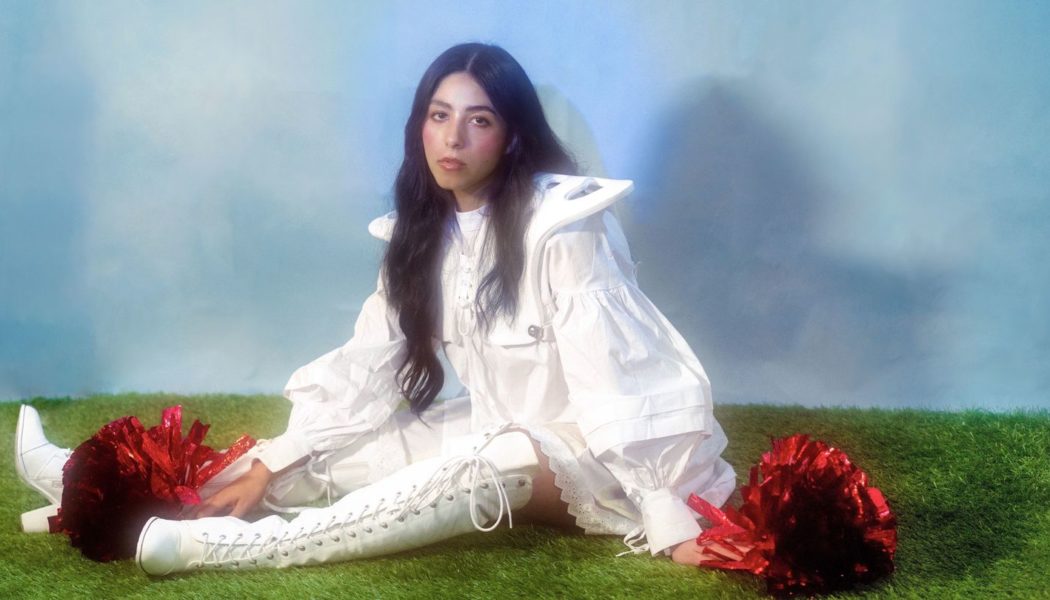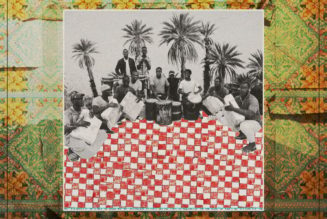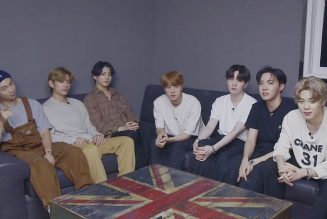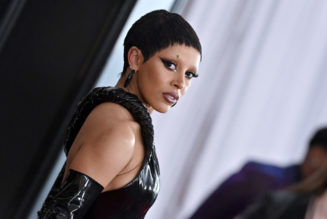
By Grant Sharples
When Mia Berrin moved to New York to study acting, she quickly realized it was a mistake. It wasn’t compatible with who Berrin is as a person, and she didn’t like the way she was treated. So she began playing in a punk band, skipping classes, and “figuring shit out,” as she tells MTV News. She released an EP called Hate It Here in 2017, but the initial lineup of her group, Pom Pom Squad, eventually dissolved. She turned to solo shows, performing with just a guitar until she eventually met her current bandmates: guitarist Alex Mercuri, bassist Mari Alé Figeman, and drummer Shelby Keller. The team was set. The shit was figured out.
“It all felt a little magical,” Berrin tells MTV News. “The day that I met them, I had been through this breakup, and I had lost my band not too long before. Suddenly, these two people [Figeman and Keller] were dropped in my lap. Alex also happened to come to the same show where I met them.” She has a friend who calls days like these, where everything meshes so effortlessly, “magnet days.” “It was a magnet day!” Berrin says.
On June 25, three years after the lineup was pulled together as if by some invisible force, Pom Pom Squad released their debut album, Death of a Cheerleader. The record, co-produced with Sarah Tudzin of Illuminati Hotties, explores sunny indie rock, power ballads in 6/8 time, a Doris Day cover, and thrashing punk. But those descriptors merely scratch the surface of Berrin’s latest effort, a swirling collection of songs that merges seemingly disparate motifs into a composite package. For that approach, she’s found inspiration in some of pop’s boldest auteurs.
“I think some of the artists that fascinate me the most right now are artists who are the genre, almost, like Billie Eilish or Rina Sawayama,” she explains. “They can go anywhere in their music, but as long as they maintain a central heart, theme, or image, it still feels like their project.” Berrin spoke to MTV News about unifying her creative approaches, the album’s striking and campy visuals, RuPaul’s Drag Race, and more.
MTV News: The album traverses so many genres in a seamless way. How did you go about meshing so many ideas into this unified vision?
Mia Berrin: I thought of it as a movie soundtrack, like what different parts of the narrative arc need. As I was writing, I was placing the songs in different slots and scenes. The song “Crying” is the perfect example, where basically I knew that, to me, the two pulls of the record were going to be more grunge-punk-indie rock-focused, and the other pull of the record was going to be lush, Motown, cinematic stuff. “Crying” was the last song that came together on the record. I knew that what was missing was a moment where both really meshed in one song. It was really hard to figure out that balance, and it almost never made it to the studio. But when it did come together, and when it did eventually get to the place that it is now, it felt like a perfect bridge in a way. It took a lot of finessing and thoughtful placement and sequencing.
MTV News: You said that you were almost letting the images come first and the music would follow. Is that the process behind Death of a Cheerleader’s songwriting? Were you writing lyrics to certain ideas and visuals that you already had in mind?
Berrin: I grew up journaling a lot, so I’ve gotten pretty good at clocking when a thought of mine could be a lyric. But in this process, there were a couple songs that had been written or existed before. “Head Cheerleader” was one of them. I think that, as I was exploring that imagery, and also thinking about growing up and not being a teenager anymore, the cheerleader image develops in that sense of my life. This idea of the death of a cheerleader came to me.
This image of being under this crazy, campy, amorphous structure just felt like a really great metaphor for where I was in my life, which was buried under this idea of femininity or this version of myself that I felt like I had to occupy to be socially acceptable to other people. Around the time I wrote “Head Cheerleader,” I had really fallen in love with somebody. It was a game-changer in terms of how I understood myself as a queer person. It all came from that emotional place, and then heightening it around this image of seeing how far I could push that was really fun.
MTV News: Something that sticks out about this album are the visuals, from the Old Hollywood-esque video for “Crying” to the marching-band-inspired aesthetics in the video for “Head Cheerleader.” What are some of the ideas you’re exploring in the iconography?
Berrin: Ever since I started Pom Pom Squad, the aesthetic of it to me has been almost equally as important as the music, if not equally important. I love when an artist can create an experience or a feeling around the record. Like if somebody associates you with a feeling, that’s a pretty big thing. I love when music can put you in a really specific headspace and bring you back to a specific moment. I think curating the world around this record has informed it in so many ways. This record actually did start with images before it started with music, oddly. I was exploring being quarantined. I had a definite desire to dissociate from my reality of being in my apartment and being in a confined space. I spent a lot of time in quarantine watching [RuPaul’s] Drag Race. It felt like everything I wanted to be and make in my artistic life: fun, campy, inspiring, sometimes really serious, and emotional.
MTV News: You have these really old songs — Tommy James and the Shondells’s 1968 psych-pop hit “Crimson and Clover” and “This Couldn’t Happen,” a version of Doris Day’s “Again” from 1949 — on the album, but they don’t feel out of place. How did you go about repurposing them for Death of a Cheerleader?
Berrin: What I love most about those songs is that they transcend their time in that they are so saccharine. “Crimson and Clover” specifically is such an unintentionally creepy song. That’s what I loved about them. There’s so much cinematic potential in that genre and in that era. A lot of times when I hear older songs repurposed in a similar way, it’s in hip-hop. I grew up on hip-hop; I was always really fascinated by sampling. I love the feeling of knowing a specific song, and then, however many years later in your life, you hear that and where the sample originated. It’s like musical worlds colliding.









